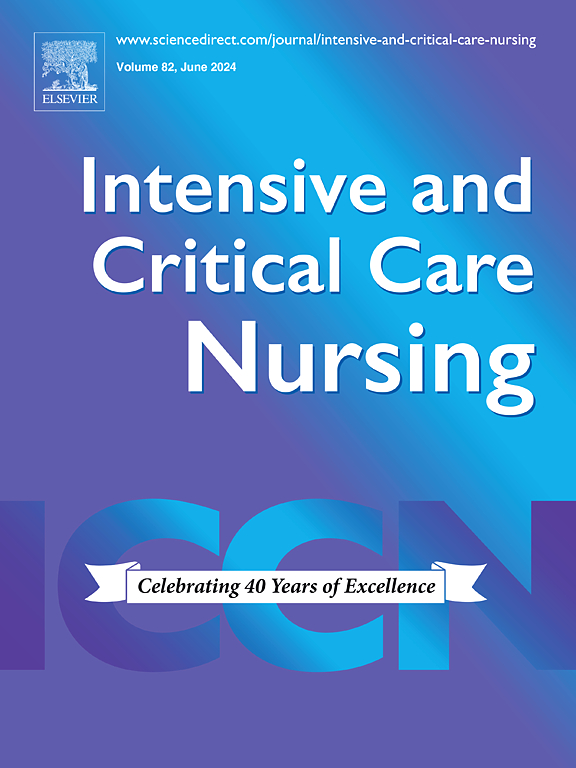COVID-19 时代气管造口相关压力损伤的全球预测因素:二手数据研究。
IF 4.7
2区 医学
Q1 NURSING
引用次数: 0
摘要
目的:确定气管造口相关压力损伤(TRPI)的发病率和风险因素,并研究 COVID-19 大流行对 TRPI 发病率的影响:确定气管造口相关压力损伤(TRPI)的发生率和风险因素,并研究 COVID-19 大流行对 TRPI 发生率的影响:设计:对全球气管造口术协作数据库和多中心医院系统的电子病历进行二次分析:患者:2019年1月1日至2021年12月31日期间住院的6400名成人和2405名儿童气管切开术患者:结果:TRPI的发生率为4.69%:结果:成人 TRPI 发生率为 4.69%,儿童为 5.65%。成人的相关风险为女性(OR:0.64)、严重肥胖(OR:2.62)、入住 ICU(OR:2.05)、袖带式气管造口(OR:1.49)、栅栏式气管造口(OR:15.37)、经皮插入(OR:2.03)和 COVID-19 感染(OR:1.66)。儿童的相关风险是糖尿病(OR:4.31)和入住 ICU(OR:2.68)。在住院的前 60 天,TRPI 的几率迅速增加。成人(OR:1.014)和儿童(OR:1.060)的年龄与 TRPI 呈正相关。黑人患者的 TRPI 发生率高于白人患者;没有发现种族的调节作用。医院群集效应(成人 ICC:0.227;儿童 ICC:0.138)表明,未测量的医院层面因素发挥了重要作用:结论:年龄增长和住院时间延长至 60 天是 TRPI 的风险因素。成人的其他风险因素包括女性性别、严重肥胖、袖带式/括口式气管切开术、经皮插入和 COVID-19;儿童的风险因素包括糖尿病和 FlexTend 装置。在 COVID-19 大流行期间入院对成人和儿童的影响截然不同。对临床实践的意义:这些发现可以指导有针对性的干预措施,以降低 TRPI 的发生率,并为公共卫生危机期间的气管造口护理提供参考。需要制定气管造口相关压力损伤的医院基准。本文章由计算机程序翻译,如有差异,请以英文原文为准。
Global predictors of tracheostomy-related pressure injury in the COVID-19 era: A study of secondary data
Objectives
To determine the incidence and risk factors of tracheostomy-related pressure injuries (TRPI) and examine the COVID-19 pandemic's impact on TRPI incidence.
Design
Secondary analysis of Global Tracheostomy Collaborative database and a multi-center hospital system’s electronic medical records.
Setting
27 hospitals, primarily in the United States, United Kingdom, and Australasia.
Patients
6,400 adults and 2,405 pediatric patients hospitalized with tracheostomy between 1 January 2019 and 31 December 2021.
Measurement
TRPI as a binary outcome, reported as odds ratios.
Results
TRPI incidence was 4.69 % in adults and 5.65 % in children. For adults, associated risks were female sex (OR: 0.64), severe obesity (OR: 2.62), ICU admission (OR: 2.05), cuffed tracheostomy (OR: 1.49), fenestrated tracheostomy (OR: 15.37), percutaneous insertion (OR: 2.03) and COVID-19 infection (OR: 1.66). For children, associated risks were diabetes mellitus (OR: 4.31) and ICU admission (OR: 2.68). TRPI odds increased rapidly in the first 60 days of stay. Age was positively associated with TRPI in adults (OR: 1.014) and children (OR: 1.060). Black patients had higher TRPI incidence than white patients; no moderating effects of race were found. Hospital cluster effects (adults ICC: 0.227; children ICC: 0.138) indicated unmeasured hospital-level factors played a significant role.
Conclusions
Increasing age and length of stay up to 60 days are TRPI risk factors. Other risks for adults were female sex, severe obesity, cuffed/fenestrated tracheostomy, percutaneous insertion, and COVID-19; for children, diabetes mellitus and FlexTend devices were risks. Admission during the COVID-19 pandemic had contrasting effects for adults and children. Additional research is needed on unmeasured hospital-level factors.
Implications for Clinical Practice
These findings can guide targeted interventions to reduce TRPI incidence and inform tracheostomy care during public health crises. Hospital benchmarking of tracheostomy-related pressure injuries is needed.
求助全文
通过发布文献求助,成功后即可免费获取论文全文。
去求助
来源期刊

Intensive and Critical Care Nursing
NURSING-
CiteScore
6.30
自引率
15.10%
发文量
144
审稿时长
57 days
期刊介绍:
The aims of Intensive and Critical Care Nursing are to promote excellence of care of critically ill patients by specialist nurses and their professional colleagues; to provide an international and interdisciplinary forum for the publication, dissemination and exchange of research findings, experience and ideas; to develop and enhance the knowledge, skills, attitudes and creative thinking essential to good critical care nursing practice. The journal publishes reviews, updates and feature articles in addition to original papers and significant preliminary communications. Articles may deal with any part of practice including relevant clinical, research, educational, psychological and technological aspects.
 求助内容:
求助内容: 应助结果提醒方式:
应助结果提醒方式:


